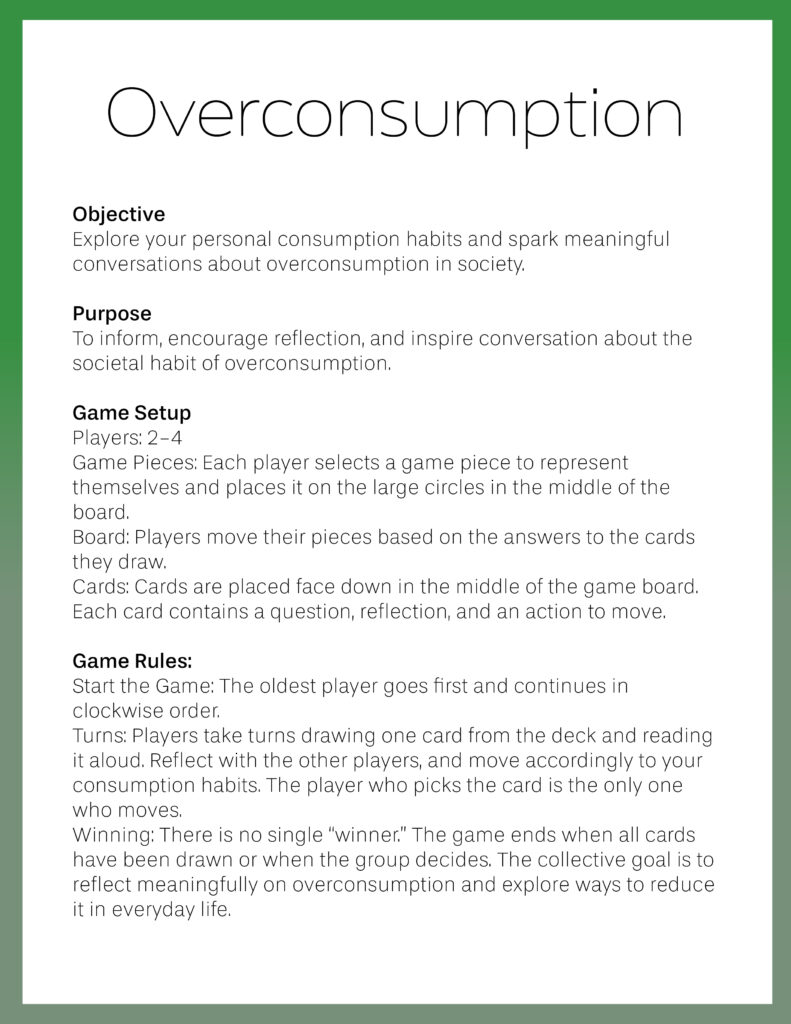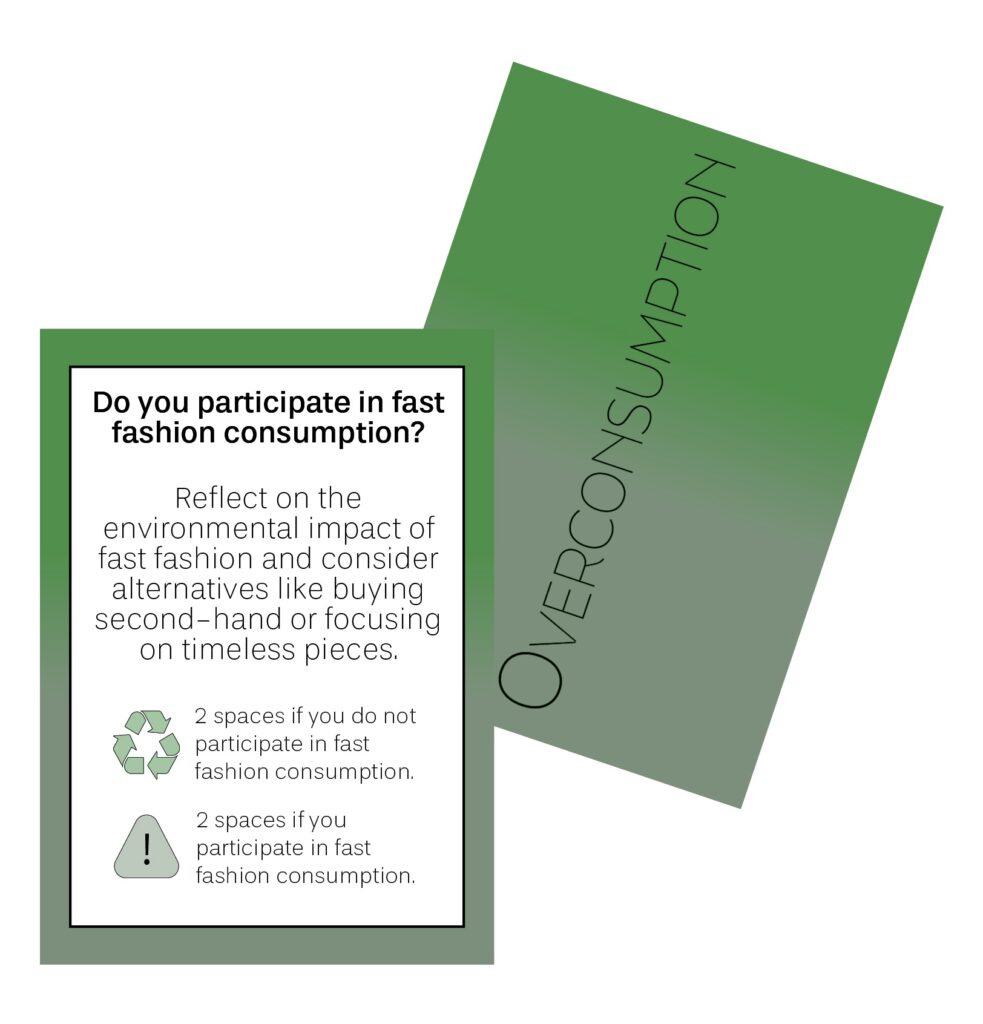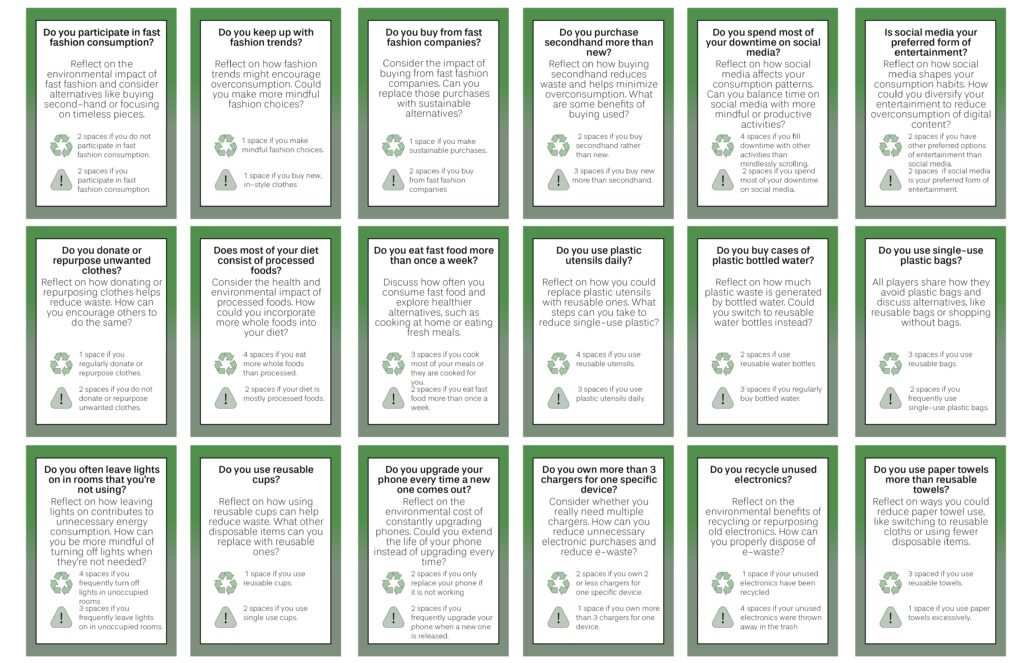





design courses, syllabi, schedules, resources and policies
I enjoy this game but it really shows how limited my vocabulary is and how slowly I can think on the spot. Evelyn mentioned when she played before all players took turns putting their pieces on the board instead of all at once. I like how we all rushed at once because it adds a more competitive aspect to the game. I think it also makes the game go faster when you have a lot of players.
My frustration with this game is that the card colors do not match the game board colors very well. I think if you are making a hues game with a lot of color variation, you better make sure the colors match correctly. I think they should really fix that because you have to look at the board code color when you are giving cues and people can tell where you are looking if you are not strategic.
I like how you get points for how many people got in the square when you care giving cues. It makes the hinter really want to think of good words because it benefits them when the other players go good.
Also I wished the board laid more flat when playing but thats just me being picky.
1. What was the most frustrating moment or aspect of what you just played?
I wish there was a list of prompts that were decided before hand.
2. What was your favorite moment or aspect of what you just played?
Giving each other complements and sharing kind words
3. Was there anything you wanted to do that you couldn’t?
I wanted to see a set of rules or at least an objective layed out
4. If you had a magic wand to wave, and you could change, add, or remove anything from the experience, what would it be?
It would be cool if each player took turns prompting other players to see how much they know about them. The game we played was more of assuming things about each other other than seeing how much you know about another person and discussing it/ sparking a conversation
5. What should be improved with the next version
rules, prompts, objective
6. What was the games message
not really sure? To see what people would write down if they knew it was anonymous
Questions to consider during play and answer after play.
1. What was the most frustrating moment or aspect of what you just played?
The only thing that was frustrating was when there was another dice added and it confused me. I didn’t really know what was happening then but then we went back to one.
2. What was your favorite moment or aspect of what you just played?
My favorite moment was when we all got to share some of our experiences with one another and relate to each other.
3. Was there anything you wanted to do that you couldn’t?
Maybe some sort of time element when sharing experiences?
4. If you had a magic wand to wave, and you could change, add, or remove anything from the experience, what would it be?
Maybe remove on the cards that all players should answer if the whole game is social and no individual card tasks.
5. What should be improved with the next version
Adding a time aspect? Arrows on the game board? I was confused what lily pad to go to next
6. What was the games message
Socializing/ sharing experiences/ relating to each other/ being supportive
7. Describe the game in 3 words.
They face the challenge of balancing: education, interactivity, detailed content, and entertainment within the game .
The game designer dismissed the game ideas proposed by the pedagogy expert and scientist because they did fit the parameters for “a game.” The scientist rejected many of the game designer’s ideas because the science was incorrect.
The design team found that including less detail would increase the amount of detail players noticed. Levels were created to entice players,
“Playtesting not only helps designers refine the game mechanics, but it can also help resolve conflicts among pedagogy, content, and gameplay by moving disagreements from theoretical stances to demonstrated success or failure of design concepts”
Tester- Alana
Questions to consider during play and answer after play.
1. What was the most frustrating moment or aspect of what you just played?
Not landing on a card space for many turns
2. What was your favorite moment or aspect of what you just played?
Getting culture cards
3. Was there anything you wanted to do that you couldn’t?
We couldn’t skip our turn when there was a group challenge so we implemented that even though it wasn’t in the rules.
4. If you had a magic wand to wave, and you could change, add, or remove anything from the experience, what would it be?
Add
– who starts first in the rules,
– list of all countries or a list of the countries that start with a certain letter on the back of the group cards
– multiple choice?
– more cards
– penalty for repeated countries?
5. What should be improved with the next version?
^^^
6. What was the games message?
Geography education
7. Describe the game in 3 words.
– Advanced
– Educational
–
Alana Tush
Crossing the bridge thoughts- I wasn’t in class so I didn’t get to see it played, but I looked up images and it looks similar to some of the other games as have looked up where you have to walk and maneuver through things with the character. It also looks similar to some modern-ish games like stick ninja or something.
What learning games have you played?
Cool math games is still fun and sum dog used to be the shit in elementary school. At the time I didn’t think I was actually learning anything or at least practicing math but it is an effective way to keep kids sharp. While I liked cool math games better, I think sumdog was a better learning game because it wasn’t as broad as cool math games.
What is ian bogost’s argument and do you agree?
His argument is that “gamification is marketing bullshit, invented by consultants as a means to capture the wild, coveted beast that is video games and to domesticate it for use in the grey, hopeless wasteland of big business, where bullshit already reigns anyway.” I agree with him, while I’m not well versed in the game community, all marketing has some twisted/ or un-true element to entice consumers.
What is a serious game and why aren’t they chocolate covered broccoli?
Serious Gaming is used to teach and provide a message. “Games that blur the line between fun and education”…can be called chocolate covered broccoli. “A coating of sweet does not make the learning suddenly fun.”
New ideas for a serious game
1. Match statistics/facts with things in nature to learn about how the environment is being effected by humans
2. Fill out a bingo card of common items that are over consumed and see the amount of over consumption you participate in. For example- owning more than 5 reusable water bottles
3. kids game where they have to practice multiplication to collect items in the grocery store to complete a recipe card. The reward is being able to cook or bake the recipe
Alana Tush
Class Discussion thoughts- I didn’t grow up playing many games, and I don’t really do so now, so I was pretty lost when everyone was discussing their thoughts on the games being presented.
Dumb Ways to Die Thoughts- what was played in class seemed to be an updated version of the game, I remember some of the levels, but some were new. I played this game a lot on my I pod touch J. It was fun when I was younger but now it just seems stupid.
Fake it to Make it Thoughts- I thought this game was a good way to show how fake news is spread. It spreads more awareness of how gullible we are than actually having fun playing the game.
Cast Your Vote Thoughts- this game shows the player how to cast a vote and shows how important it is to make an educated decision rather than blindly voting.
Generate a list of five game ideas that revolve around the theme of empathy. Wrinkle: Take one of the five ideas and make it an alternate reality game.
Kindness Bingo– complete acts of kindness to fill a bingo card, encouraging positive behavior.
Feelings Charades– act out emotions, helping players recognize and empathize with different feelings.
Role Reversal- Players switch roles in a scenario, (parent/child, professor/student) to experience challenges from each other’s point of view
From chapter 1:
How does Mary Flanagan’s definition of game differ from chris Crawford’s as well as the definition crafted by Katie Salen and Eric Zimmerman?
Mary Flanagan’s definition- “Games can be thought of more productively as situations with guidelines and procedures.”
Chris Crawford’s definition- Games can evolve, and rules may shift at certain points in a game and can change with the player’s actions.”
Katie Salen and Eric Zimmerman definition- “system in which players engage in an artificial conflict, defined by rules, that results in a quantifiable outcome.”
Mary Flanagan’s definition has less structure than Katie Salem and Eric Zimmermans’ outline of a game.
What is an activist game?
Activist games have emphasis on social issues, education, and intervention. They are games that engage in a social issues through: themes, narratives, roles, settings, goals, and characters.
From chapter 3:
– Go and chess are examples of games that feature “perfect information”, what other games share that feature?
Perfect information- “all the information constituting the system of the game is visible on the game board at all times. Play in an abstract strategy game often unfolds as players move pieces on the board, creating a set of ongoing puzzles for other players to thwart.”
Examples- checkers, scrabble?, tic tac toe
– Why might chance or gambling games hold spiritual or religious importance to ancient cultures?
They saw games as a way to connect with the powers of fate, chance, and the afterlife.
– When was the earliest battle between government/ religious groups and games? what modern games can you think of that have been banned or demonized?
European’s in the Middle Ages were captivated by the game and the church fought to forbid its play. The battle between government or religious groups and games is at least as old as this event, if not much older. When faced with the popularity of style games in Europe, the church decided to use the game to further its religious message.
– What is a fox game, and what would be a modern example?
Fox game- board games featuring unequal opponents, one player is the fox, or aggressor. Other players control or play the prey. The fox attempts to avoid the traps his opponents set all around him.
– What was the purpose or intent of the game: Mansion of Happiness?
Purpose- “Children would take these principles to heart and connect wholesome thoughts to the secular joys of competing for positions, projecting themselves into situations of good and evil, and enjoying the company of their playmates and family.” Reinforcing good morals
– Why do artists from the Fluxus and Surealist movements play games? Why did Surealists believe games might help everyone?
They play games as form of recreation and research.
– Changes in what can signal profound changes in games? How were pinball games reskinned during WW2?
Changes in the economy can signal profound changes in games. “Pinball gained widespread popularity in the United States, United Kingdom, and France, mass- produced as a popular pastime for military men.”